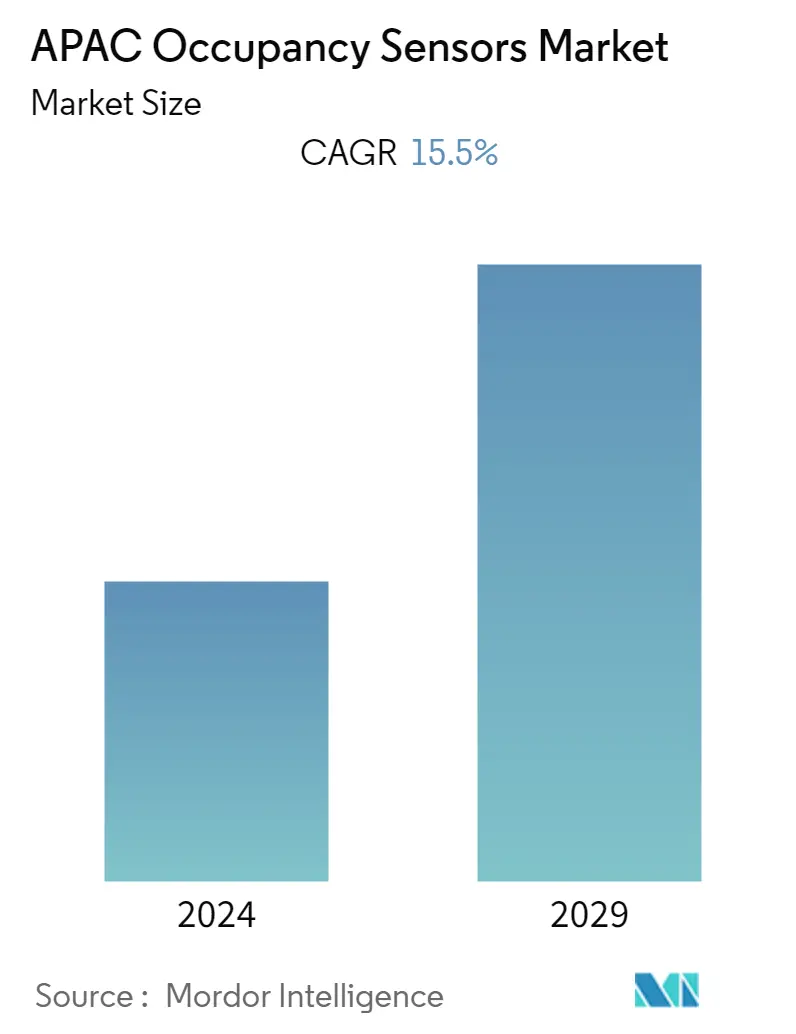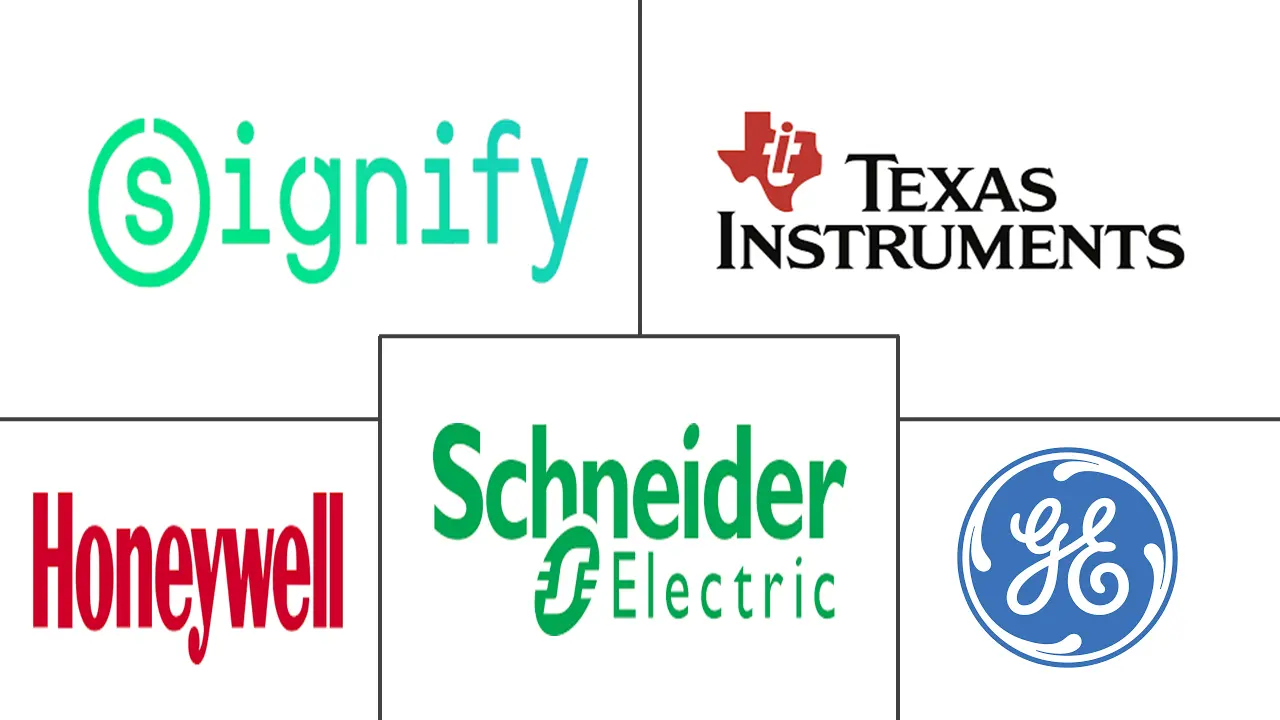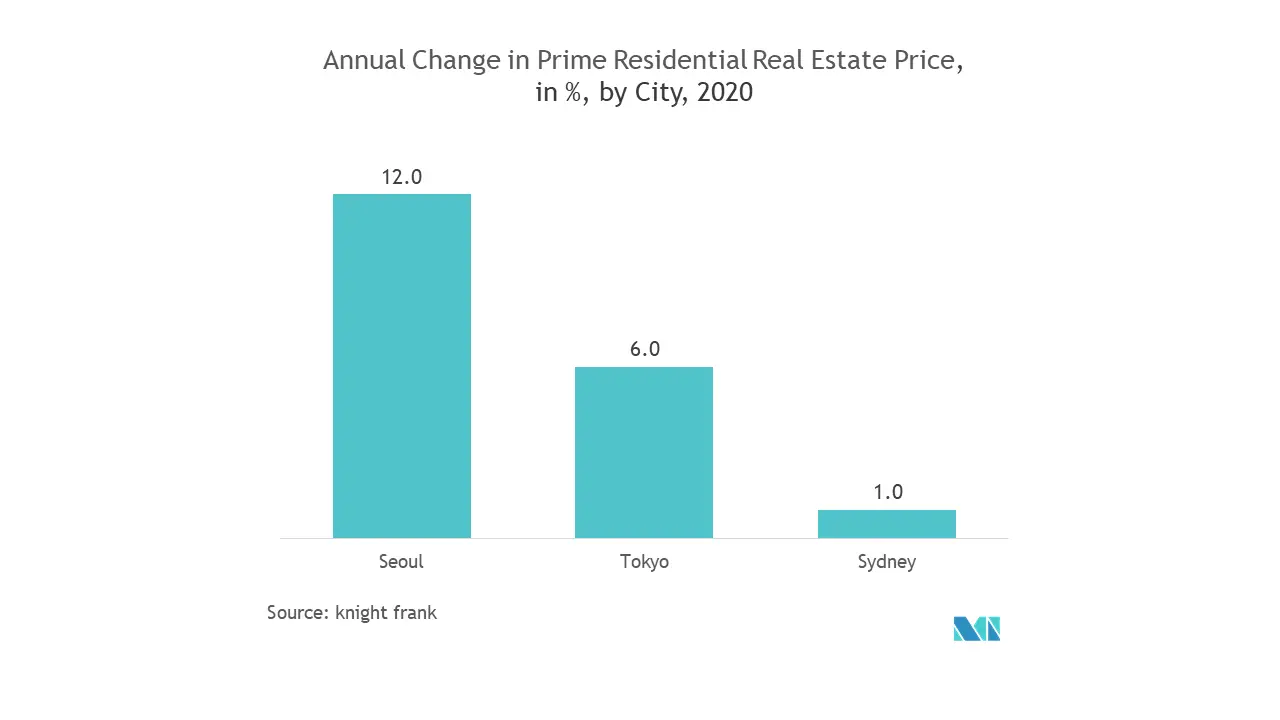APAC Occupancy Sensor Market Size

| Study Period | 2019 - 2029 |
| Base Year For Estimation | 2023 |
| Forecast Data Period | 2024 - 2029 |
| Historical Data Period | 2019 - 2022 |
| CAGR | 15.50 % |
| Market Concentration | Medium |
Major Players
*Disclaimer: Major Players sorted in no particular order |
APAC Occupancy Sensor Market Analysis
The Asia Pacific Occupancy Sensors Market is expected to register a CAGR of 15.5% during the forecast period, 2021-2026. Smart building technology and occupancy sensors can provide real-time data, allowing to make better decisions for building management under the new guidelines of COVID-19. Whether saving space or improving hygiene, occupancy IoT sensors can help mobilize and optimize the back-to-work process.
- Occupancy sensors indicate the presence or absence of occupants in a space using various technologies such as passive infrared, ultrasonic, and dual-technology. Passive-infrared sensors necessitate a line of sight between the sensor and the space's occupants.
- Further, to reduce energy waste, most energy codes require some method of automatically turning off lights when they are not in use, either on a schedule or based on occupancy. Occupancy sensors are lighting controls that turn off lights in unoccupied areas, lowering energy costs by reducing energy waste. Also, various vendors in the region are introducing Ultrasonic sensors to detect the presence of people by emitting ultrasonic sound waves into the environment and measuring the speed with which they return.
- Also, there is an increasing focus on Dual-technology sensors that use both passive infrared and ultrasonic technologies to detect the presence of occupants and activate the lights only when both technologies detect the presence of occupants. This configuration virtually eliminates the possibility of false-on problems, and requiring either technology to keep the lights on significantly reduces the possibility of false-off problems.
- Private companies are partnering with vendors to become energy efficient. For instance, Larsen & Toubro Infotech (LTI) partnered with 75F to eliminate challenges related to inefficient lighting. 75 installed its Advanced Lighting Solution to improve occupant experience. As a result, LTI achieved an energy saving of 55%.
APAC Occupancy Sensor Market Trends
This section covers the major market trends shaping the APAC Occupancy Sensor market according to our research experts:
Residential Expected to Witness Significant Growth
- With the introduction of smart building technologies, facility managers now have access to robust tools to access accurate information about space occupancy rather than relying on estimates and approximations and occupancy sensors aiding in collecting data about space usage and optimizing space management decisions in the region.
- Also, switch from a traditional lighting control system to a smart lighting control system, which allows for wireless and even touchless lighting control through occupancy sensing, time scheduling, and voice control. All of this has opened up new opportunities for professional lighting control companies, which provide flexible solutions to homes.
- Further, Photoelectric infrared (PIR) sensors are the current standard for detecting occupancy presence in buildings. Smart thermostats use sensors to control heating and cooling based on occupancy. One significant issue is that these PIR sensors only detect individuals moving.
- Additionally, occupancy sensor and smart outlet reference designs help home automation device makers and developers accelerate time to market while lowering system cost and complexity. Developers can quickly advance from design concept to final product by leveraging these new, turnkey reference designs, including pre-certified wireless technology, open-source hardware design files, industry-standard software stacks, and proven test setups manufacturing methods.

India Expected to Witness Significant Market Share
- The initiation of technically sophisticated occupancy sensors for various applications fuels security and access systems demand by providing a user-friendly and reliable service. Aside from that, various commercial establishments such as IT companies, enterprises, data centers are implementing access control systems to protect personnel and data breaches, to record employee's entry and exit timings.
- The rising demand for energy-efficient devices is expected to drive the country. Occupancy sensors play a vital role in reducing energy consumption. This is achieved through the sensors, which shut down devices and other equipment based on occupancy. These sensors help reduce light pollution and can be used for indoor and outdoor spaces.
- The demand for passive infrared is expected to continue in the country due to the low cost, demand for energy-efficient devices, and less power requirement. It has a range of applications, such as lighting, spectrometers, gas, and fire detection systems. Some of the significant benefits of passive infrared sensors are accurate movement detection, reliable triggering, and cost-efficiency. Vending machine designers, for instance, are now incorporating PIR sensors into their products so that their displays only light up when someone is standing in front of the unit or maybe waving their hand in front of a panel, which saves on operating costs.
- Further, the market is witnessing various innovations. For instance, in October 2021, Wozart, a Smart Home tech company based in Hyderabad, India, announced a product designed to work with Apple HomeKit. The Sense Pro multi-sensor is intended to function similarly to an occupancy sensor while including several other features. The Sense Pro uses a combination of methods (dubbed TrueOccupancy), including thermal imaging and built-in AI, to determine whether people are in a given room and whether a person has entered or exited the room with the sensor designed to sit above the room's entrance.

APAC Occupancy Sensor Industry Overview
The Asia Pacific Occupancy Sensors Market is moderately competitive in nature. Product launches, high expense on research and development, partnerships, and acquisitions are the prime growth strategies adopted by the companies in the region to sustain the intense competition.
- July 2021 - Arcline Investment Management, a private equity firm, announced purchasing a majority stake in Dwyer Instruments. The company is a provider in designing and manufacturing sensor and instrumentation solutions for the process automation, HVAC, and building automation markets. The company has 93 active and pending patents and an extensive suite of over 40,000 configurable SKUs, allowing it to service nearly all customer-required applications.
- January 2021 - Eyeris Technologies, Inc. announced a collaboration with Texas Instruments (TI) on an industry-first in-cabin sensing AI solution at the Consumer Electronics Show (CES) 2021, utilizing TI's JacintoTM TDA4 processors and 2D RGB-IR image sensors. Eyeris DNNs are designed to meet functional safety standards, allow for flexible camera placement, and perform efficiently on low-power edge processors. Eyeris' AI algorithm portfolio for in-cabin sensing includes driver monitoring system (DMS) and occupant monitoring system (OMS) features that meet global NCAP standards.
APAC Occupancy Sensor Market Leaders
-
Signify Holding BV
-
Texas Instruments Inc
-
Schneider Electric SE
-
Honeywell Inc
-
General Electric Co
*Disclaimer: Major Players sorted in no particular order

APAC Occupancy Sensor Market News
- March 2020 - Signify introduced new Philips IoT sensor packages that gather and deliver data via the Interact Office connected lighting system and environmental monitoring APIs. The sensor bundles can observe occupancy, the total of people in the room, temperature (at the room and desk level), noise levels, daylight levels, relative humidity, and are Bluetooth enabled, allowing for indoor positioning and navigation.
APAC Occupancy Sensor Market Report - Table of Contents
1. INTRODUCTION
- 1.1 Study Assumptions and Market Definition
- 1.2 Scope of the Study
2. RESEARCH METHODOLOGY
3. EXECUTIVE SUMMARY
4. MARKET INSIGHTS
- 4.1 Market Overview
-
4.2 Industry Attractiveness - Porter's Five Forces Analysis
- 4.2.1 Bargaining Power of Suppliers
- 4.2.2 Bargaining Power of Consumers
- 4.2.3 Threat of New Entrants
- 4.2.4 Threat of Substitutes
- 4.2.5 Intensity of Competitive Rivalry
- 4.3 Assessment of the Impact of COVID-19 on the Market
5. MARKET DYNAMICS
-
5.1 Market Drivers
- 5.1.1 Rising Demand for Energy Efficient Devices
- 5.1.2 Demand for Passive Infrared Due to Low Cost and High Energy Efficiency
-
5.2 Market Challenges
- 5.2.1 False Triggering of Switch and Inconsistency Issues Associated with Wireless Network Systems
6. MARKET SEGMENTATION
-
6.1 By Network Type
- 6.1.1 Wired
- 6.1.2 Wireless
-
6.2 By Technology
- 6.2.1 Ultrasonic
- 6.2.2 Passive Infrared
- 6.2.3 Microwave
-
6.3 By Application
- 6.3.1 Lighting Control
- 6.3.2 HVAC
- 6.3.3 Security and Surveillance
-
6.4 By Building Type
- 6.4.1 Residential
- 6.4.2 Commercial
-
6.5 By Country
- 6.5.1 China
- 6.5.2 Japan
- 6.5.3 India
- 6.5.4 Rest of Asia Pacific
7. COMPETITIVE LANDSCAPE
-
7.1 Company Profiles
- 7.1.1 Schneider Electric SE
- 7.1.2 Eaton Corp PLC
- 7.1.3 Signify Holding BV
- 7.1.4 Honeywell Inc
- 7.1.5 Dwyer Instruments Inc
- 7.1.6 Johnson Controls Inc
- 7.1.7 General Electric Co
- 7.1.8 Legrand SA
- 7.1.9 Analog Devices Inc
- 7.1.10 Texas Instruments Inc
- *List Not Exhaustive
8. INVESTMENT ANALYSIS
9. FUTURE OF THE MARKET
** Subject To AvailablityAPAC Occupancy Sensor Industry Segmentation
An occupancy sensor is used to save energy, comply with building codes, and provide automatic control and various other such applications. One of the most-used technologies among the occupancy sensors is the passive infrared, which detects occupancy within a specific field and activates lighting, and is extremely useful in small spaces. Moreover, the advent of advanced occupancy sensors, such as micro-phonics, intelligent occupancy sensors, image processing occupancy sensors, and the new vision-based intelligent occupancy sensor, for HVAC systems is fueling the growth of the occupancy sensor market.
| By Network Type | Wired |
| Wireless | |
| By Technology | Ultrasonic |
| Passive Infrared | |
| Microwave | |
| By Application | Lighting Control |
| HVAC | |
| Security and Surveillance | |
| By Building Type | Residential |
| Commercial | |
| By Country | China |
| Japan | |
| India | |
| Rest of Asia Pacific |
APAC Occupancy Sensor Market Research FAQs
What is the current APAC Occupancy Sensors Market size?
The APAC Occupancy Sensors Market is projected to register a CAGR of 15.5% during the forecast period (2024-2029)
Who are the key players in APAC Occupancy Sensors Market?
Signify Holding BV, Texas Instruments Inc, Schneider Electric SE, Honeywell Inc and General Electric Co are the major companies operating in the APAC Occupancy Sensors Market.
What years does this APAC Occupancy Sensors Market cover?
The report covers the APAC Occupancy Sensors Market historical market size for years: 2019, 2020, 2021, 2022 and 2023. The report also forecasts the APAC Occupancy Sensors Market size for years: 2024, 2025, 2026, 2027, 2028 and 2029.
APAC Occupancy Sensors Industry Report
Statistics for the 2024 APAC Occupancy Sensors market share, size and revenue growth rate, created by Mordor Intelligence™ Industry Reports. APAC Occupancy Sensors analysis includes a market forecast outlook to 2029 and historical overview. Get a sample of this industry analysis as a free report PDF download.



